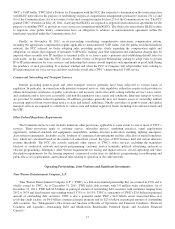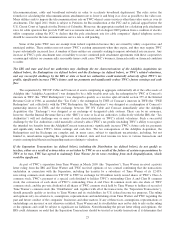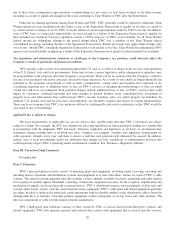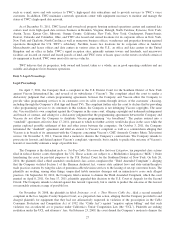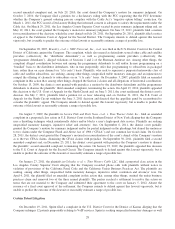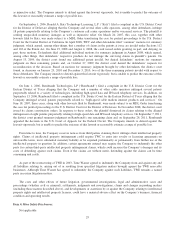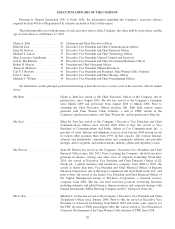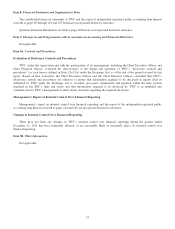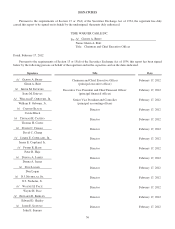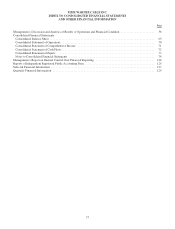Time Warner Cable 2011 Annual Report Download - page 35
Download and view the complete annual report
Please find page 35 of the 2011 Time Warner Cable annual report below. You can navigate through the pages in the report by either clicking on the pages listed below, or by using the keyword search tool below to find specific information within the annual report.such as e-mail, news and web services to TWC’s high-speed data subscribers and to provide services to TWC’s voice
customers. In addition, TWC maintains a network operations center with equipment necessary to monitor and manage the
status of TWC’s high-speed data network.
As of December 31, 2011, TWC leased and owned real property housing national operations centers and regional data
centers used in its high-speed data services business in Herndon, Virginia; Raleigh, North Carolina; Syracuse, New York;
Austin, Texas; Kansas City, Missouri; Orange County, California; New York, New York; Coudersport, Pennsylvania;
Denver, Colorado and Columbus, Ohio, and TWC also leased and owned locations for its corporate offices in New York,
New York and Charlotte, North Carolina as well as numerous business offices, warehouses and properties housing regional
operations throughout the U.S. TWC’s subsidiary, NaviSite, leases two locations for its corporate office in Andover,
Massachusetts and leases offices and data centers in various cities in the U.S., an office and data centers in the United
Kingdom and an office in India. TWC’s signal reception sites, primarily antenna towers and headends, and microwave
facilities are located on owned and leased parcels of land, and TWC owns or leases space on the towers on which certain of
its equipment is located. TWC owns most of its service vehicles.
TWC believes that its properties, both owned and leased, taken as a whole, are in good operating condition and are
suitable and adequate for its business operations.
Item 3. Legal Proceedings.
Legal Proceedings
On April 7, 2011, the Company filed a complaint in the U.S. District Court for the Southern District of New York
against Viacom International Inc. and several of its subsidiaries (“Viacom”). The complaint asked the court to render a
declaratory judgment that certain programming agreements between the Company and Viacom allow the Company to
provide video programming services to its customers over its cable systems through devices of the customers’ choosing,
including through the Company’s iPad App and Smart TVs. The complaint further asks the court to declare that by providing
video programming services to its customers in this fashion, the Company is not infringing Viacom copyrights. The same
day, Viacom filed its own complaint against the Company in the same court, alleging copyright and trademark infringement
and breach of contract, and asking for a declaratory judgment that the programming agreements between the Company and
Viacom do not allow the Company to distribute Viacom programming “via broadband.” The parties entered into a
“standstill” agreement, effective June 17, 2011, pursuant to which no further activity would take place in the cases while the
parties explored possible settlement of this and other issues between the companies. On October 3, 2011, the Company
terminated the “standstill” agreement and filed an answer to Viacom’s complaint as well as a counterclaim alleging that
Viacom is in breach of its agreement with the Company concerning Viacom’s CMT (formerly Country Music Television)
service. On November 2, 2011, Viacom filed a motion to dismiss the Company’s counterclaim. The Company intends to
prosecute its lawsuit, and defend against Viacom’s complaint, vigorously, but is unable to predict the outcome of Viacom’s
lawsuit or reasonably estimate a range of possible loss.
The Company is the defendant in In re: Set-Top Cable Television Box Antitrust Litigation, ten purported class actions
filed in federal district courts throughout the U.S. These actions are subject to a Multidistrict Litigation (“MDL”) Order
transferring the cases for pre-trial purposes to the U.S. District Court for the Southern District of New York. On July 26,
2010, the plaintiffs filed a third amended consolidated class action complaint (the “Third Amended Complaint”), alleging
that the Company violated Section 1 of the Sherman Antitrust Act, various state antitrust laws and state unfair/deceptive
trade practices statutes by tying the sales of premium cable television services to the leasing of set-top converters boxes. The
plaintiffs are seeking, among other things, unspecified treble monetary damages and an injunction to cease such alleged
practices. On September 30, 2010, the Company filed a motion to dismiss the Third Amended Complaint, which the court
granted on April 8, 2011. On June 17, 2011, plaintiffs appealed this decision to the U.S. Court of Appeals for the Second
Circuit. The Company intends to defend against this lawsuit vigorously, but is unable to predict the outcome of this lawsuit
or reasonably estimate a range of possible loss.
On November 14, 2008, the plaintiffs in Mark Swinegar, et al. v. Time Warner Cable Inc., filed a second amended
complaint in the Los Angeles County Superior Court, as a purported class action, alleging that the Company provided to and
charged plaintiffs for equipment that they had not affirmatively requested in violation of the proscription in the Cable
Consumer Protection and Competition Act of 1992 (the “Cable Act”) against “negative option billing” and that such
violation was an unlawful act or practice under California’s Unfair Competition Law (the “UCL”). Plaintiffs are seeking
restitution under the UCL and attorneys’ fees. On February 23, 2009, the court denied the Company’s motion to dismiss the
27


